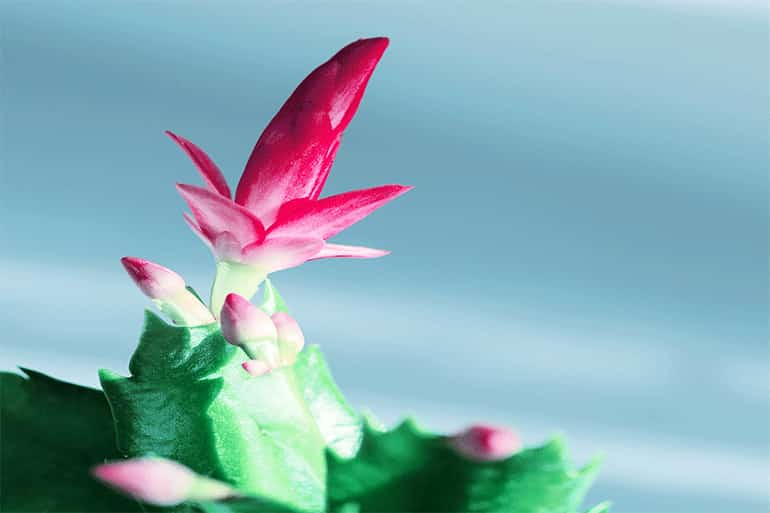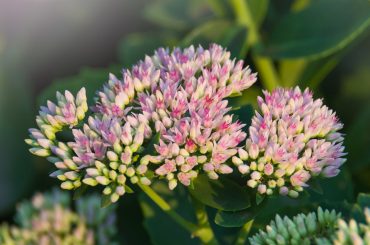If you are a flower lover, then you must have heard of the Thanksgiving cactus. When your summer flower plants remain barren during the winter and fall, these plants are the ones to brighten up the sad background by adding splash of color. How lovely!
Yes, we are talking about How to Grow Schlumbergera Russelliana Cactus. This plant member of the Cactaceae Family, commonly known as the Thanksgiving cactus, can liven up your house in winter with its bright, lovely flowers. Not to mention, they make excellent holiday gifts.
And you know what? Growing this plant is not hard at all. If you apply the proper technique, you can grow Schlumbergera Russelliana Cactus very easily.
Even better is that the procedure is quite affordable. So what are we waiting for? Let’s begin learning, shall we?
Schlumbergera Russelliana Cactus | A Brief Introduction
But before we jump to learning about the propagation of Schlumbergera Russelliana Cactus , why don’t we learn a bit about the plant itself first? After all, the better we know about the plant, the better we will be able to take care of it.
Do you know? Schlumbergera russelliana is originally a perennial plant native to South-East Brazil. It was first introduced in Europe in 1839.
Though we call S. russelliana a cactus, primarily, it is an epiphyte. In the wild, this tropical plant grows on either rocks or other plants.
The flattened green stems of the plant are composed of segments. These flattened segments’ are 0.5-1.5 inches in length and 0.5 to 0.75 inches in width.
But these are not all when it comes to Schlumbergera russelliana. If you want to learn more, check out the table bellow-
Botanical name | Schlumbergera Russelliana Cactus | |
| Synonyms | Cereus russellianus Epiphyllum russellianum Phyllocactus russellianus | |
| Common names | Holiday Cactus Thanksgiving Cactus Winter Cactus Shrimp Cactus Crab Cactus | |
| Plant type | Epiphyte | |
| Maintenance | Medium | |
| Growth rate | Medium | |
| Height | 10-12 inches | |
| Sunlight preference | Indirect exposure to bright light | |
| Soil type | Light soil | |
| Soil pH | Neutral (6.0-8.0) | |
| Soil drainage | Moist with good drainage | |
| Bloom time | Fall Winter | |
| Flower
| size | 1-3 inches |
| shape | Tubular | |
| color | Pink Purple Red White Yellow | |
| Time | October- February | |
| Fruit | Type | Capsule |
| Color | Greenish-yellow | |
| Lifespan | 20-30 years | |
| Region of origin | South-East Brazil | |
| Popular hybrids | S. Buckley (S. russelliana × S. truncate) S. eprica Supplier (S. orssichiana × S. russelliana) | |
An excellent plant indeed. Now that we know quite a bit about it, time to move on to the next part.
Do you Have a Thanksgiving cactus, or a Christmas cactus?
We all know that Schlumbergera Russelliana Cactus is a Thanksgiving cactus. But do we know what a Thanksgiving cactus is, and how does it differ from a Christmas cactus?
Many confuse Thanksgiving cacti with Christmas cacti. It is because, at first glance, they all look almost similar. All of them have leaf-like segmented stems and tubular-shaped flowers.
But if you spare a second glance and check the leaf edges, you will notice the difference. The edge of the leaves of the Thanksgiving cactus is toothed and serrated.
On the contrary, the Christmas cacti have more rounded scalloped-edged leaves. See, simple to recognize when you know it.
Required Items to grow Schlumbergera Russelliana Cactus
No matter how great a chef you are, you won’t be able to cook rice without rice. The same applies to growing plants. And what will you need?
- Healthy cactus cuttings or seeds
- Growing medium
- Container/pot/jar
- Clay pebble/gravel
- Spraying bottle/watering can
How to Grow Schlumbergera Russelliana Cactus | A Guide
We have finished our preparation, so it’s time to start. It may seem unbelievable, but propagating Schlumbergera Russelliana Cactus is relatively easy.
You can grow them from either seeds or cuttings. To be honest, growing S. russelliana from cutting is way easier than growing them from seeds.
Growing Schlumbergera Russelliana Cactus From Cutting | Propagation of Thanksgiving cactus
First, let’s discuss how we can grow Schlumbergera Russelliana Cactus from cuttings. Providing the cuttings an environment suitable for generating roots is the key. It doesn’t matter whether you root them in water or in soil.
The warm months like April to September are suitable for this method. Remember; don’t take the cuttings until at least one month passes after flowering.
When a suitable time comes, use a sharp scissor to cut at the joints between the stem’s fleshy segments. The cuttings should be at least 4 inches long and have 3-5 segments.
Now it is time to choose your propagating method and act accordingly.
Propagation In Water
- First, take a clean glass jar.
- Fill the bottom of the jar with pebbles around two inches deep.
- Add water until it reaches the top of the stones.
- Place your cutting’s bottom in the water touching the pebbles.
- Place and secure the cutting in a way to keep the majority of it over the water.
- Keep it in a shaded area near sunlight.
- Monitor regularly and add water when it comes close to drying out.
- Wait for the roots to grow.
- Then transfer it into a garden pot.
Propagation In Soil
- To propagate the cuttings in soil, first, you need to heal the wound from the cut unlike water propagation.
- To do so, place the cuttings in a cool, dry place with enough indirect light for 2-4 days, until the cut ends callous over.
- Now take a container and fill it up with an appropriate potting mixture of perlite and peat in 1:3 ratios.
- Moist, not wet the soil with water. Then plant the calloused end of the cuttings about 1-inch deep in the soil to keep it upright.
- Now, place the pot in a shaded, but the sunlit area where the cutting can receive bright but indirect sunlight.
- Remember to water regularly, but only enough to keep the soil moist.
- In 3-12 weeks, you will get a new Thanksgiving cactus.
Growing Schlumbergera Russelliana Cactus From Seeds
Growing Schlumbergera from seeds requires more care than growing them from cuttings. But still, the steps are quite straightforward.
- First, nick the seeds a little using sandpaper, a small knife, or fingernails.
- Then soak them for several days in lukewarm water. Remember to daily change the water.
- Afterward, keep them in a cold area for about four weeks.
- Fill a pot with 1:3 ratios perlite and peat mix.
- Now, place the seeds on the mixture and lightly cover them.
- Place the pot in a shaded area and keep the soil moist but not wet.
- It will take a few weeks for the seeds to germinate.
- Then, transplant them into a larger pot.
Transplanting the plant
For water-based cutting propagation and seed propagation, you will need to transfer the cactus into a pot after the propagation succeeds. As these tropical cacti prefer humidity yet dryer soil, the growing medium should be prepared thus to accommodate them.
- First, select a medium-size gardening pot.
- Then fill up one-fifth of it with pebbles for better water drainage.
- Later fill up the rest with a 2:3 ratio perlite and potting soil mixture until it reaches the top 1 inch.
- Press the soil a little and plant the cactus.
Schlumbergera Russelliana Cactus Care Methods
Now that you have your cactus, it is time to wait and take care of them well. It will need 2-3 years to flower, so be patient, okay?
Schlumbergera Russelliana Cactus doesn’t require too much maintenance. Just give it an appropriate environment, and it will remain healthy. Remember to pay extra attention to the environment around the plant.
Sunlight
As well all know by now, this plant loves sunlight, but not direct contact. Keep it in a lightly shaded area where it can have indirect sunlight throughout the day.
Temperature
The plants prefer 60 to 65F, or about 15C temperature, especially during flowering. It doesn’t do well with higher temperatures. So, you can just keep it in a nice, cool place inside your house.
Humidity
Russelliana prefers humidity but not soggy soil. In fact, it can collect water from humid surroundings, so overflowing the pot can cause root-rot.
Water it enough to keep the soil moist but not thoroughly dry out, especially during the flowering period. A suitable method of doing so is to thoroughly water it first under the sink and let the excess water drain through the hole.
Then place it in its spot and water only when the upper layer of the soil dries out.
Fertilizers
Organic fertilizers are the best for Schlumbergera Russelliana Cactus. You can produce them in your home free of cost.
Simply blend eggshells, banana peels, used tea leaves, and some veggie-peels together. Just use 1 TBSP of the mixture when you fertilize the plant.
The cactus needs fertilizers only during the blooming period and the growth time in spring. During those times, fertilize it every two weeks.
How to make Schlumbergera Russelliana Cactus bloom?
It feels frustrating when your plant does not bloom despite your heartfelt care. Well, in many cases, it’s not the plant’s fault. You just couldn’t provide it with the incentive to bloom, that’s all.
When it comes to Schlumbergera Russelliana Cactus, the temperature and light is the key. The optimum temperature for blooming your cactus is 60-65F. Also, it requires daily exposure to total darkness for 12 to 14 hours straight.
We suggest you keep it in a cool, dark place such as inside a closet from evening till morning. Hopefully, after 3-4 weeks, your tree will flower.
Few Tips About Schlumbergera Russelliana Cactus
- Schlumbergera contains toxins. So keep them out of children and pet’s rich.
- Spring-time pruning can increase its growth.
- Mushy, limp leaves indicate root rot.
- Reddish leaves are a sign of excessive sun exposure and lack of water and phosphorus.
- It is vulnerable to mealy bugs, and spider mite insects’ infestation. Use insecticidal soap spray to fight them.
Final Thoughts
Now that we are at the end of our discussion, what do you think? Do you think you can grow your very own Schlumbergera russelliana cactus now?
This article contains a thorough discussion on how to grow Schlumbergera russelliana cactus, from propagation to blooming. You shouldn’t have any problems if you follow the methods carefully.
Just give it a try. Hopefully, you will have your own Thanksgiving cacti-blooms to brighten up your house in the next holidays.





